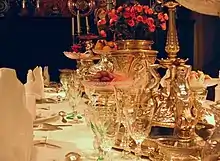Tablescaping
Tablescaping, or table-setting, is an activity involving the setting of themed dining tables in artful, decorative ways for social events, and in a variety of categories for competitions.[1][2][3][4][5] Tablescaping is a portmanteau of table and landscaping; it was coined by television chef Sandra Lee in 2003.[6] In the United States, competitions take place at county fairs, and events across the country; competitive tablescaping traces back to at least the 1930s.[2][7] The creations are “rigorously judged” with points lost for glassware, cutlery, and plates, and other items missing or out of place, while points can be gained for creativity or interpretation of a theme.[7][8] Other criteria considered can include aesthetics, functionality, balance, and the corresponding fictional menu that would accompany the table’s meal; an entry can use a formal table setting, or be quite casual depending on the theme.[8][9] The practice has become better known since the rise in social media posts centered on meals people share including the setting; on photo-sharing Instagram, as of November 2019, #tabledecor has 1.9 million posts, and #tablesetting has 2.3 million posts.[4] A counterintuitive trend is for a rustic or farm theme, with a sustainability aesthetic emphasizing materials and components that are recycled, and upcycled.[6]

Tablescaping can also refer to any decorative treatment for a ”console, coffee, side, or center table”.[10]
History

Table-setting became a Western craze in the late 1700s, when the aristocracy used the practice as a self-expression form.[6] Themed tablescapes have since then provided an “escape from daily life to a fantasy world”.[6] Flatware, dishes, glassware, and supplementary pieces kept being introduced with the trend peaking in the Victorian Era (1837–1901), with about twenty expensive items per setting “contributed to the table’s shiny new look”.[6] According to Slate, it was the shift from 1750 to 1900, and from service à la française—when courses were served en masse and diners served themselves buffet-style—to service à la russe, where courses followed one after the next and were portioned out by servants.[6] The changeover meant that instead of a visual feast of the former method, there was a void as serving dishes were now on a side table leaving the dinner table more bare which led to “elaborate, sometimes absurd, table settings”.[6] Expensive centerpieces soon followed as a way to display one’s wealth.[6] In the mid 1700s “ornate silver baskets called epergnes, long mirrored trays called plateaus, flowers, and candelabras” were employed.[6]
In the late 1800s middle class families in Europe and America emulated the wealthy but relied on fresh flowers as centerpieces.[6] In the mid-1900s women’s gardening clubs held display exhibitions to promote table decorating.[6]
Other tablescapes

References
- "Up next, recap & links". CBS News Sunday Morning. January 3, 2020. Retrieved January 5, 2020.
- Connor, Knighton (January 5, 2020). Cardin, Chad (ed.). "Setting the Table". CBS News Sunday Morning. Retrieved January 5, 2020.
- Doyle, Jessica (November 30, 2019). "How to master tablescaping with Instagram star Mrs Alice and the woman she learnt it all from - her mum". The Telegraph. ISSN 0307-1235. Retrieved January 5, 2020.
- Burroughs, Katrina (November 24, 2019). "The art of tablescaping". The Sunday Times. ISSN 0956-1382. Retrieved January 5, 2020.
- Nguyen, Lilly (July 11, 2019). "Decor contestants help set the table for O.C. Fair opening". Daily Pilot. Retrieved January 6, 2020.
- Griffin, Mackensie (May 5, 2015). "The Strange, Creative, and Occasionally Tacky History of Table Settings—Excuse Me, Tablescapes". Slate Magazine. Retrieved January 6, 2020.
- Flegg, Eleanor (November 9, 2018). "Find your place: Discover competition tablescaping". Independent.ie. Retrieved January 6, 2020.
- Wright, Andy (July 26, 2017). "The Fiercely Precise World of Competitive Table-Setting". Atlas Obscura. Retrieved January 6, 2020.
- Vallieu, Melody (August 12, 2016). "Dinosaurs take win in Tablescaping competition - Piqua Daily Call". Piqua Daily Call. Retrieved January 6, 2020.
- McKeough, Tim (July 23, 2019). "Mastering the Art of the Tablescape". The New York Times. ISSN 0362-4331. Retrieved January 6, 2020.